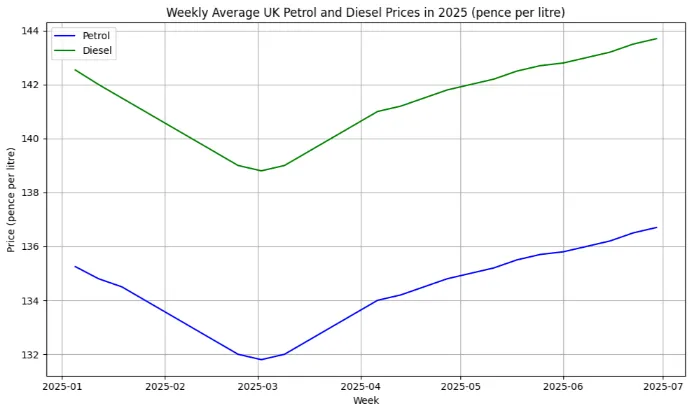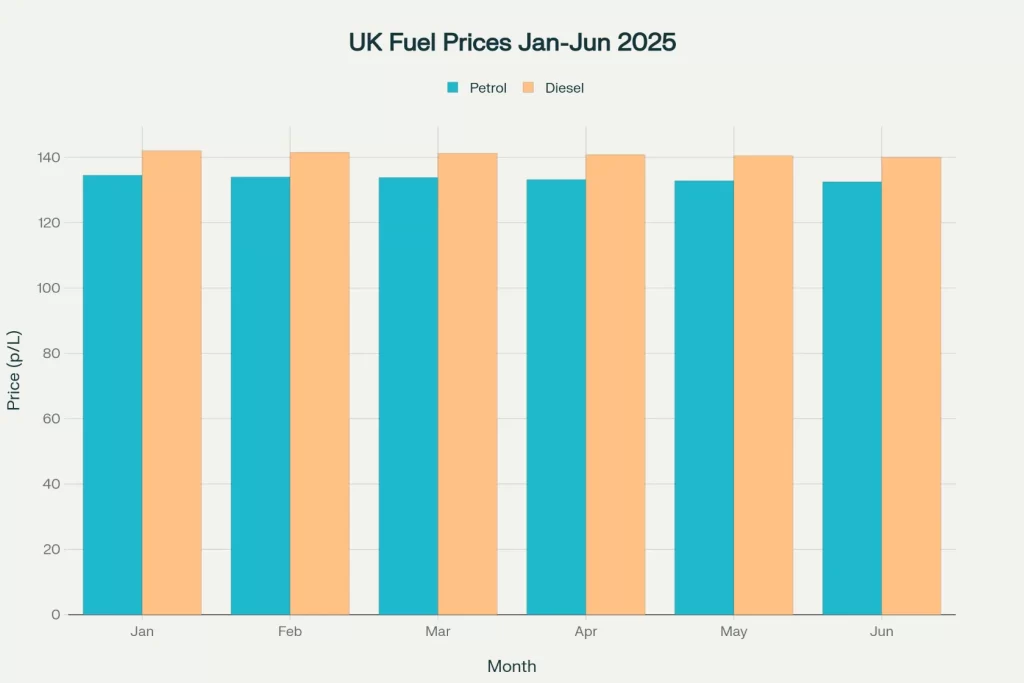UK Fuel Trends 2025 : Prices, Policies, and the Push for Renewables
Introduction
Welcome to the guide on UK fuel trends for 2025. This year features significant shifts in fuel prices, important government policies, and a strong national effort toward renewable energy. The UK is at a turning point, facing global instability, new transparency rules, and ambitious goals for clean energy. In this blog, we break down the latest fuel price data, highlight key policy changes, and provide insights into the nation’s path to renewable energy leadership. Read on for updated facts, actionable information, and a clear view of what the future holds for the UK’s energy landscape.
For more insights on the broader energy industry trends, check out Energy Price Forecasts and the Energy Industry in 2025.
2025 UK Fuel Price Overview
Latest Petrol and Diesel Prices
As of July 2025, UK petrol prices averaged 134.64 pence per litre, while diesel was at 141.95 pence per litre. Compared to previous years, these prices are somewhat lower than the peaks during recent global crises but higher than historical averages from the early 2020s 111.
| Fuel Type | Average Price (July 2025) |
|---|---|
| Petrol | 134.64p per litre |
| Diesel | 141.95p per litre |
In early July 2025, petrol prices rose above 133p/litre for the first time in two months, with diesel remaining about 7-8p higher than petrol. The cost to fill a standard 55-litre petrol car is around £75, while filling a diesel car costs approximately £78, remaining £6-£7 less than last year due to earlier price fluctuations balancing out 1.
Historical Perspective and Price Movement
UK fuel prices have been very unstable in recent years. Spring 2022 experienced a significant spike, followed by a quick drop as global markets reacted to the Russia-Ukraine war, supply issues, and changing post-pandemic demand.
While the average pump price at the start of 2025 is lower than during the turmoil of 2022-2023, industry analysts do not expect this stability to last. Oil price shocks, currency fluctuations, and geopolitical risks still loom, particularly with ongoing instability in the Middle East and the effects of new government regulations 9.
For a deeper dive into UK fuel price trends, visit UK Fuel Prices to Start 2025 Lower Year-on-Year but Volatility to Remain.
Factors Influencing UK Fuel Prices
Crude Oil and Global Market Dynamics
UK fuel prices closely follow crude oil pricing. In 2025, oil prices have remained relatively stable at around $70-75 per barrel, though they can spike due to OPEC+ decisions, regional conflicts, and macroeconomic factors. The UK imports a large portion of its refined oil products, so global market changes directly affect domestic fuel prices 9.
Taxation and Duty
Taxes, including fuel duty and VAT, make up a significant part of UK fuel costs. Although the 5p per litre duty cut introduced in 2022 is still in effect, industry experts agree that taxes and levies, rather than wholesale oil prices, are the main reasons for the high pump prices 9.
Refining and Distribution Costs
Diesel prices are usually higher than petrol due to more complicated refining processes and greater production costs for diesel fuels. Distribution inefficiencies, retailer margins, and competition among supermarkets and independent sellers also impact regional price differences 11.
Government Policies Shaping the Fuel Market
New Fuel Finder Scheme
One of the major policy changes for 2025 is the launch of the Fuel Finder scheme. By the end of the year, all supermarkets and major retailers must report price and availability changes within 30 minutes. This data will go directly to apps, sat-navs, and websites, helping drivers find the cheapest local option right away 11.
Key Points:
- Real-time retailer reporting will boost competition.
- More transparency is expected to lower pump prices by 1-6 pence per litre.
- The policy follows strong recommendations from the Competition and Markets Authority (CMA), which found that drivers were often overcharged at the pumps even after previous actions.
Competition and Market Regulation
Additional measures include closer monitoring by the Competition and Markets Authority of retail spreads and margins. These efforts aim to ensure that supermarket dominance—which supplies around 40% of all UK fuel—benefits consumers through better pricing rather than limiting competition 11.
Taxation and Subsidy Adjustments
The government is using a balanced approach to meet climate goals and address cost concerns:
- Ongoing support for fuel duty cuts to lessen the impact on consumers during price increases.
- Windfall taxes on North Sea oil and gas producers to fund green energy projects.
- Committed investment in new energy infrastructure, including storage and next-generation renewables 6.
For more on UK energy policies, see The Landscape for UK Renewable Energy in 2025.
The 2025 Push for Renewables
National Commitments
The new government, elected on a strong net-zero platform, has quickly broadened renewable energy support:
- Launch of GB Energy, a government body focusing on clean power transition.
- Removal of the effective ban on onshore wind installations.
- Fast-tracking of three major solar farms, adding over 1.4 GW to solar capacity 6.
Renewable Share of Energy Mix
By mid-2025, 44.4% of electricity generation by major power producers came from renewables, with 38.9% from gas and 14.8% from nuclear. Offshore wind, in particular, has become the leading energy source, providing nearly a third of total renewable output 1.
For a historical perspective, read UK 20-Year Energy Mix Trend Shows Commitment to Cleaner Energy.
Conclusion: The Road Ahead
2025 is a pivotal year for the UK’s energy landscape, where new policies, stronger market oversight, and ambitious net-zero goals are changing how people drive, power their homes, and fuel industries. Although oil and diesel prices are still affected by global trends, government actions have made a significant impact on transparency and competition. Renewables are growing rapidly, and ambitious sustainable transport rules are setting the UK apart globally.
Ongoing vigilance, innovation, and consumer engagement will be crucial as the country moves beyond 2025 toward a truly sustainable energy future. This future must balance affordability, security, and environmental care for the generations to come.
For the latest government energy statistics, visit Energy Trends and Prices Statistical Release.on, and consumer engagement will be crucial as the country moves beyond 2025 toward a truly sustainable energy future. This future must balance affordability, security, and environmental care for the generations to come.

